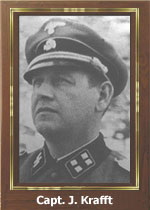 SS Major Josef 'Sepp' Krafft.
This unit was not a full-strength battalion, and Krafft's men were not all fully
trained. It was the German custom to send partially trained recruits to the occupied
countries so that they could complete their training and at the same time act as defense
units in those countries. Krafft and his battalion HQ, two recruit companies and various
other elements had come to this part of Holland from a location on the coast in early
September to strengthen the German presence around Arnhem; a third company was being
formed, bringing the unit's total strength on the morning of 17 September to 306.
SS Major Josef 'Sepp' Krafft.
This unit was not a full-strength battalion, and Krafft's men were not all fully
trained. It was the German custom to send partially trained recruits to the occupied
countries so that they could complete their training and at the same time act as defense
units in those countries. Krafft and his battalion HQ, two recruit companies and various
other elements had come to this part of Holland from a location on the coast in early
September to strengthen the German presence around Arnhem; a third company was being
formed, bringing the unit's total strength on the morning of 17 September to 306. The officers and NC0's were all veteran soldiers, but most of their men were young recruits, although every one was of pure German stock and full of SS zeal. Krafft's war diary refers to the excellent training in 'world philosophy', i.e. Nazism, imparted by the unit's political officer, Obersturmfuhrer Rauli, who would die for his ideals within the next few days.
Part of the unit was based in Arnhem, the remainder in Oosterbeek. On the morning of the airborne landings, the battalion 's No. 2 Company had been carrying out a training exercise in the woods between Oosterbeek and Wolfheze and was now at the Hotel Wolfheze; its men had killed Lieutenant Timmins. Krafft himself was in Arnhem, where he had brought the remainder of his unit to readiness after the preliminary air raids. Every German unit had been given instructions on what action to take immediately when an airborne landing occurred. When the glider and parachute landings were reported, Krafft realized that his was the nearest unit with a fighting capability to the landing area. He judged that a force as large as that reported landing - estimated at between 3000 and 4000 strong (even that was a low estimate) - could only have as its objective something as important as the local Rhine bridges, particularly the road bridge in Arnhem. There were four possible routes that the airborne force could use: the main Amsterdam-Arnhem highway in the north, the railway line, the Utrecht-Arnhem road and the minor road in the south along the bank of the Rhine. Krafft did not have sufficient strength to block all four routes. He decided that the two central ones, the railway line and the Utrecht road, were more important because the British would probably take the most direct route to their objective; a marked map found on a British motorcyclist captured in mid-afternoon seemed to confirm that decision. Krafft issued his orders.
No. 2 Company at the Hotel Wolfheze was to attack the landing area at once. 'We knew from experience,' the war diary says, 'that the only way to draw the teeth of an airborne landing with an inferior force is to drive right into it.' But the war diary then goes into a flight of fantasy in reporting that No. 2 Company subsequently sent its heavy machine-gun section into action on the glider landing zone north of Wolfheze: 'This created great confusion and wreaked great havoc. The troops from about four gliders were completely wiped out and the gliders shot to pieces.' Nothing of the sort took place.
Krafft's subsequent moves were more effective. He ordered Nos. 2 and 4 Companies to form a north-south blocking line just east of Wolfheze, covering the railway line and the Utrecht road lines of possible approach to Arnhem. He brought up his battalion headquarters and established it at the Hotel Wolfheze, in the center of the line. Some Dutch 'terrorists' seemed to be interfering with part of these moves were 'suitably dealt with'. By his swift and decisive action, Krafft had his men in position by 3.30 p.m., an hour and an half after the end of the landings and just before the units of the 1st Parachute Brigade set out towards Arnhem. By gathering every possible extra man, the German battalion now numbered 435. The number of men in the British units setting out from the landing area towards Arnhem was about 2000. Rarely can the disposition of a small force such as Krafft's have had such an effect upon a battle.